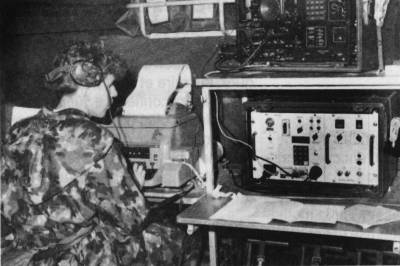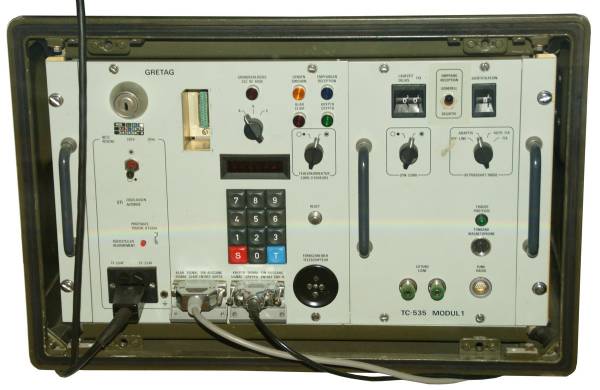Inhaltsverzeichnis
Telecrypto 535
Telecrypto 535, TC-535; manufactured by Gretag AG, Regensdorf.
As a successor to the mechanical TC-61 ciphering machine, Gretag developed a digital encryption system in 1968/78, which was first used with the SE-222 and later with the SE-430.
Technical data
- Principle: Digital encryption system
- Operation modes: Bitstream encryption
- Operation modes: CCITT No.2 (Baudot code), CCITT No.5 (ASCII code)
Power supply
- Mains operation: 220 V AC mains, 80 Watt
Dimensions
- 534 x 360 x 436 mm; 29 kg
Accessories
- Module 1 or 2
System material
The Data encryption set Telecrypto 535 consists of a fully digital encryption system built into a transport case, which can encrypt data fully automatically in Baudot and ASCII format at a wide range of baud rates from 12.5 to 1200 baud.
The structure key is stored in a plug-in E-EPROM, and a basic key consisting of sixteen digits can be entered via a keypad on the front panel; three different keys can be stored. In addition, an additional key is generated for each transmission; this is transmitted openly and is used to change the basic key so that a different key is generated for each transmission.
Statistical filler text is transmitted during transmission pauses. This „jumble of numbers“ makes decryption more difficult, as a lot of effort is wasted trying to decrypt these random letters if the remote station cannot recognise the start of transmission.
The central module with 12 modules is mounted in the set on the left side. Two different plug-in modules can be fitted on the right side of the front panel. Module 1 allows the transmission of teletype, telephony and radio signals at speeds between 12.5 and 1200 baud. Only this module has a connection for a teleprinter using the closed-circuit current method.
Module 2 contains the synchronous modem for transmitting telephony and radio signals at 1200, 2400 or 4800 baud. Both modules allow the connection of telephone lines via the terminals La, Lb.
The shift between the „0“ and „1“ states is 200, 400 or 800 Hz for module 1 and 60 Hz for the return channel and for fast transmission using module 2.
The set has an internal power supply, which can withstand voltage drops of up to 28 seconds without losing the basic key setting. The built-in digital clock continues to run for at least 20 days when powered by a NiCd battery.
The set cannot communicate in clear mode, after switching it to the clear standby position it only provides the current for the teleprinter so that punched tape with the clear text can be prepared. However, these tapes cannot be sent.
In normal operation, the system works in crypto mode, the start character QQQQQ is preceded by a crypto template generated from the time and basic key of the encrypted message when the set is operating with module 1 in teletype mode. In operation with module 2, a synchronisation template followed by the additional key transmitted three times is transmitted before the ciphertext; the additional key is generated from the basic key and time information. The final command PPPPP completes the transmission; in crypto-synchronised mode, the ciphertext from the random generator continues to be transmitted even during pauses in operation.
The set can communicate between two points or in a network. In a point-to-point connection or a two-party network, alternating traffic takes place automatically (FIX or in AUTO FIX mode, the transmission time can be measured so that synchronisation information no longer needs to be exchanged afterwards). In a network with up to 5 stations (A, B, D, F, G), the transit time differences in the radio network or wire network can be taken into account in ADAPTIVE mode running over microwave relay paths. The transmitting station communicates with the other four and the synchronisation is re-triggered with each transmission.
In networks with more than five stations, the master station and the first four stations work with the identification addresses A - G as described above, all other stations are assigned an identifier (identification on the black field or NEUTRAL) and must be called specifically, the transmission is synchronised with QQQQQ and the station name and terminated with PPPPP or the communication can be continued with station A with automatic change of direction by transferring the final command AAAAA.
In OFF-LINE operation mode, the connected teletypewriter is used to encode or decode character by character, for example if a message recorded on tape or cassette is to be decoded; a maximum speed of 300 Bd is recommended when using module 1. Module 2 can be used at higher transmission speeds to store ciphers digitally on a magnetic tape.
Technical principle
Components
The set is completely solid state.
Development
The TC-535 was developed as a fully digital system as the successor to the mechanical TC-61 ciphering machine in 1968/78 by Gretag AG in Regensdorf.
Use
 The Telecrypto-535 was procured in 1979/80 and was initially used together with the SE-222 and then with the SE-430 short-wave radio station for command communications within the army framework.
The Telecrypto-535 was procured in 1979/80 and was initially used together with the SE-222 and then with the SE-430 short-wave radio station for command communications within the army framework.
Technical documentation
- Bedienungsanleitung Telekrypto 535, Gretag AG


